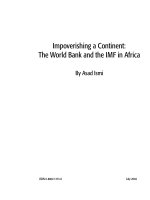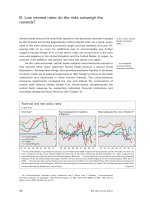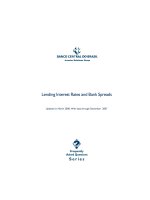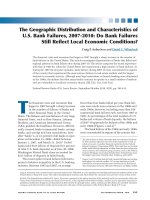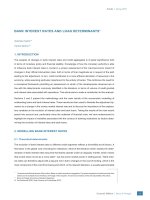Zero Interest Rates and the Fall in U.S. Bank Lending pdf
Bạn đang xem bản rút gọn của tài liệu. Xem và tải ngay bản đầy đủ của tài liệu tại đây (34.35 KB, 7 trang )
1
Zero Interest Rates and the Fall in U.S. Bank Lending
Ronald McKinnon
1
Stanford University
October 2009
(Forthcoming in Journal of Economic Asymmetries)
Abstract
The wholesale interbank market (where banks trade with each other) reduces the risk for banks
making forward commitments to lend at retail— to households and firms, including exporters
and importers. The collapse of the U.S. housing bubble in 2007-08 impaired bank balance sheets
so that banks became reluctant to lend to each other from counterparty risk. Consequently retail
bank credit fell sharply, thus worsening the crisis. By 2009, the U.S. government had responded
by re-capitalizing large commercial banks and by flooding the system with liquidity so as to
drive short-term interest rates close to zero. Although counterparty risk is now in abeyance,
forcing short-term interest rates to zero is a serious mistake. Wholesale interbank lending is still
inhibited so that retail bank credit is unlikely to recover—and continues to fall in 2009.
JEL Classification: E4 and E5
Key Words: Liquidity trap, exit strategies, interbank market, credit crunch
Introduction
Since the credit crunch and global downturn in 2008, governments everywhere have
responded to the shortfall in aggregate demand in a standard textbook Keynesian fashion. To
degrees, they have adopted fiscal stimuli: ramping up government expenditures and cutting
taxes. Central banks followed the lead of the U.S. Federal Reserve by driving down short-term
interest rates toward zero: almost exactly zero for overnight interbank rates in the U.S., Japan,
and Canada, and generally less than 1 percent in Europe into the Fall of 2009.
In a statement on September 23, 2009 following a two-day meeting by the Fed’s policy
makers, the central bank repeated that it would keep its benchmark overnight interest rate at
virtually zero for an “extended period”. That almost certainly means at least some time in 2010
2
.
But are these near-zero interest rates the appropriate policy response?
1
I would like to thank Mario Nuti for most helpful comments
2
Levine Breaking News, Sept 23, 2009
2
In late 2009, with partial recovery, or at least a noticeable slowing, of the global
downturn, a rather heated debate on exit strategies has emerged. The G-20 finance ministers
agreed on “the need for a transparent and credible process for withdrawing the extraordinary
fiscal, monetary and financial sector support as recovery becomes firmly secured”. But how and
when to start withdrawing the support remains controversial.
One group of protagonists sees unsustainable fiscal deficits and the extraordinary
overhang of excess bank reserves as a portent of a monetary explosion and looming inflation.
Indeed some commodity markets—notably gold and oil—seem to be frothy, and the dollar is
weak again. They argue for withdrawing the stimulus.
Countering this, a second group points to the high and possibly still rising unemployment
in the U.S. and Europe, coupled with excess capacity, as an effective barrier to any near-term
outbreak of inflation in 2009—or even 2010. In the aggregate, they see potential supply still
looking much higher than demand. This group worries that any withdrawal of stimulus now
would be premature—much as in the Great Depression, when U.S. fiscal and monetary
retrenchment in 1937 cut short a nascent economic recovery after 1933.
How best can we sort out these competing arguments? By disaggregating the U.S.
stimulus package into its relevant components, one can identify some elements that can and
should be exited immediately without undermining—and perhaps even strengthening— the
expansionary impact of the whole regime. Here I focus just on monetary policy, which is under
the control of just one entity: the U.S. Federal Reserve Bank. And because the world is still
largely on a dollar standard, what the Fed does strongly influences other central banks around the
world.
The key point is that the Fed should raise short-term interest rates from near zero to
modest levels—say 2 percent. Long 10- or 30-year bond rates would be largely unaffected or
could even fall. But in the current zero-interest liquidity trap, such a modest increase in short
rates has distinct advantages:
1. In the huge but still constricted wholesale interbank market, constraints on borrowing
or lending at medium terms to maturity would be largely relaxed. Only then can
general bank credit at “retail” i.e. to firms—including exporters and importers—and
households increase. Surprisingly, retail bank credit in the both the U.S. and Europe
is still declining.
2. The sharp weakening of the dollar against the euro and other important currencies
from July to October 2009 would be curbed, thus preventing a new dollar carry trade
that diverts American bank lending to foreigners.
3. China, having led world recovery—or at least the Asian part of it—with a massive
expansion of domestic bank credit and fiscal stimulus, could better rebalance its
economy. It could become more restrictive with slightly higher interest rates without
again being deluged with inflows of hot money from the U.S.
In this short paper on what is a large and complex subject, I will discuss just the first—
and the least self-evident of the three points.
3
Wholesale Interbank Markets: Counterparty Risk and Zero Short-Term Interest Rates
In the current crisis, the Keynesian response of stimulating aggregate demand through
easy money and loose fiscal policy is correct to a point. But flooding the system with excess
liquidity that drives short-term interest rates to near zero has been a serious mistake. By the end
of 2008, the interest rates on federal funds and short-term Treasury Bills were virtually zero—
where they remain today (figure 1). In this liquidity trap, the interbank market remains almost
paralyzed so that further Fed injections of liquidity simply led to a buildup of excess reserves in
U.S. commercial banks without stimulating new lending to households and nonbank firms.
After the financial panic began in July 2008, figure 2 shows that the Fed responded by
more than doubling the stock of base money, which reflects the huge increase in commercial
bank reserves from the Fed’s extraordinary purchases of financial assets from the private sector.
However, M2—a broad measure of deposits held by the nonbank public— only increased a
modest 5 percent, reflecting an offsetting large fall in the base money multiplier. Most
disappointing of all, figure 2 also shows that retail bank lending declined and continues to
decline so far in 2009. Insofar as U.S. commercial banks did slightly increase their net assets as
the counterpart of the modest increase in M2, it was to buy securities such as government bonds
or mortgages fully insured by the government. But increased working capital for businesses,
especially small and medium sized, languished despite the gargantuan efforts of the Fed to
expand the size of the banking system.
Why was it a mistake for the Fed to flood the system with so much liquidity that short-
term interest rates were driven toward zero? In line with textbook economic theory, the Fed
focused mainly on the shortfall in aggregate demand rather than on the underlying supply
constraint on credit availability. However, starting from a position where interest rates are
already very low, say 2 percent as in early 2008, reducing them to zero has only a second-order
effect on expanding aggregate demand. But going from 2 percent to zero has a first-order effect
of tightening the credit constraint on the supply side. Although in 2009 the economy may show a
“dead cat bounce” from supercharging aggregate demand through fiscal policy, leaving the fed
funds rate at zero makes it impossible for the resumption of normal bank credit to support
investment growth in future years.
Because credit is an input into working capital, a credit constraint acts very much like a
supply constraint on physical capital. In either case, dumping more liquidity into the system does
not increase output. But why should congestion in the wholesale interbank market constrain
banks who see good retail lending opportunities? Why don't such banks just raise their interest
rates to final (retail) borrowers enough to maintain their profit margins and willingness to lend?
This is an important and not generally understood point. Retail lending involves making
risky forward commitments, much like transacting in forward markets in foreign exchange. For
example, a bank might open a line of credit to a well-known corporate customer that could be
4
drawn upon over the next year. But below some well-defined maximum, the customer chooses
when to draw it down, and by how much.
The willingness of banks to make such forward commitments to lend to nonbank firms
and households depends very much on the wholesale interbank market. If the wholesale
interbank market works smoothly without counter party risk at positive interest rates, then even
currently illiquid banks can make forward loan commitments to their retail customers. If such a
bank happens to be still illiquid when a corporate customer suddenly draws down its credit
line, the bank can cover its retail commitment by bidding for funds in the wholesale market at
close to the "risk-free" interest rate. Because the riskiness of making forward retail loan
commitments is thereby reduced, the bank’s willingness to do more retail lending increases.
(Otherwise, without participating in the interbank market, each commercial bank would have to
hold much higher liquid reserves against its potential retail lending opportunities.)
Now suppose some upsetting event, such as a crash in home prices makes all mortgage
related assets on bank balance sheets suspect. Then counter party risk becomes acute, and banks
become less willing to lend to each other unsecured. Because the LIBOR market is unsecured,
one very rough measure of counterparty risk from the U.S. housing crash is the difference
between the federal funds rate, which is fully secured by repo agreements based mainly on
Treasury bonds as the collateral, and the unsecured LIBOR. Figure 1 shows that before mid 2007
(when the crisis began), the one-month LIBOR rate closely tracked the fed funds rate. Then after
mid 2007, LIBOR began to edge above the federal funds rate before spiking sharply in late
summer and fall of 2008 to more than 200 basis points above the fed funds rate. With the benefit
of hindsight, we know that this was the most acute phase of last year’s financial panic when
interbank trading dried up. Thus, in 2008, the main constraint on interbank trading was
counterparty risk.
Governments everywhere responded to the panic by pumping more equity into banks,
greatly expanding the ambit of their deposit insurance, and opening up various central bank
discount windows for distress borrowers. This gigantic effort seems to have reduced
counterparty party risk, the fear of bank failure, in interbank trading. Figure 1 shows the one-
month LIBOR rate coming down close to the Fed funds rate, now near zero, by mid 2009.
In 2009, however, with counterparty risk in abeyance but not completely vanquished, the
zero interest rate policy became an important supply-side constraint on the resumption of normal
interbank trading. Positive rates of interest at all terms to maturity are necessary for restoring
normal borrowing and lending in the wholesale interbank market. Only then will banks that are
liquid, i.e., have excess reserves but no good future lending opportunities at retail, lend to those
that are illiquid—i.e., those with good retail lending opportunities in domestic or foreign trade
but no excess reserves. But if the risk-free federal funds rate is close to zero, banks with excess
reserves will not bother parting with them for a derisory yield.
Interest rates don’t have to be very high to unblock private interbank markets— just 1 to
2 percent. However, banks with surplus reserves but without good retail lending opportunities
need some profit margin for them to play their vital intermediary role of lending to illiquid banks
with better retail opportunities. Otherwise the Federal Reserve itself has to be the intermediary
5
by using the (excess) reserves of the commercial banks lodged with it to lend directly to the
private sector—for example, by buying commercial bills directly from large corporations. Apart
from the potential undesirable political biases in government direct lending, small- and medium-
sized firms—which that cannot issue marketable commercial bills— are still left starved for even
normal bank credit.
I have made a distinction between “illiquid” and “liquid” banks without specifying much
in the way of an institutional frame work for distinguishing between the two classes. Indeed,
banks that are illiquid in any one period need not be in the next. Being illiquid seems pejorative,
but it is not if, at any point in time, it includes banks with the better (forward) retail lending
opportunities. Also, with the government’s massive injections of new equity into large banks,
their counterparty risk may have been substantially eliminated—as shown by the convergence of
LIBOR to the federal funds rate in 2009.
However, residual counterparty risk could still be lodged in smaller U.S. banks among
which there have been numerous failures so far in 2009. Indeed, LIBOR only reflects average
interest rates for trade among the world’s 20 or so largest banks in London. It need not reflect the
plight of smaller banks, which have not been beneficiaries of government largess. But smaller
banks are the natural lenders to small- and medium-sized enterprises, which seem the most
stressed in the current downturn. Thus, figure 2 could reflect a huge build up of excess reserves
concentrated in large banks while, simultaneously, many small and medium sized banks—
without easy access to the interbank market— reduce their (retail) lending thus making a robust
recovery in the United States impossible.
International Implications
The international consequences of zero-interest-rate policies are also negative. With
interbank markets in the U.S. and Europe congested, forward foreign exchange markets become
more difficult to organize. Without forward cover, exporters and importers find it more difficult
to secure normal letters of credit. In the financial panic of 2008, foreign trade imploded much
more than domestic trade.
In addition, the Fed’s zero interest rate strategy inevitably weakens the dollar in the
foreign exchanges. Besides complicating the management of recovery in other countries facing
inflows of hot money from the United States, it heightens the long-term inflationary threat to the
United States itself. The American position at the center of the world dollar standard is further
jeopardized when foreign holdings of dollar exchange reserves bear only a derisory low yield as
the dollar depreciates.
6
Figure 1: U.S. Short-term Interest Rates (%)
Source: Federal Reserve Economic Data and globalfinancialdata.com
0
1
2
3
4
5
6
7
8
9
10
Jan-06 Jul-06 Jan-07 Jul-07 Jan-08 Jul-08 Jan-09 Jul-09
Fed Funds Rate
1-month LIBOR
1-month Treasury bill
Sep
7
Figure 2: Loans and leases of U.S. commercial banks, base money and M2 (2006 Jan = 100)
Source: Federal Reserve Economic Data
50
100
150
200
250
Jan-06 Jul-06 Jan-07 Jul-07 Jan-08 Jul-08 Jan-09 Jul-09
Loans and leases
Base Money
M2
Sep

